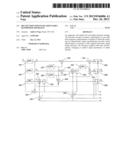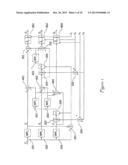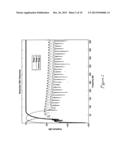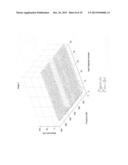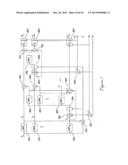Patent application title: Dectection-enhanced adjustable bandwidth apparatus
Inventors:
Andrew Noga (Rome, NY, US)
IPC8 Class:
USPC Class:
702 70
Class name: Electrical signal parameter measurement system waveform analysis waveform extraction
Publication date: 2013-12-26
Patent application number: 20130346006
Abstract:
An apparatus and method for providing spectrum sensing. The invention
accepts as inputs a spectrogram or any other time frequency
representation of signals in which the resulting two-dimensional output
representation provides useful characteristics or features of the
original time/series signal being analyzed. The invention employs both
time and frequency averaging to exploit signal persistence in either
domain.Claims:
1. A detection enhanced adjustable bandwidth signal detection apparatus,
comprising: a first filter bank comprising a plurality of filters, all
into which an N-element data vector is input; a first detector into which
the output of a last filter in said first filter bank and the output of a
second summer are compared; a first multiplier into which the output of
said first detector is multiplied by the output of a first subtractor,
wherein the output of said first multiplier is input into a second filter
bank comprising a plurality of filters; said first subtractor for
subtracting the output of a first filter in said second filter bank from
the output of said first filter in said first filter bank; a second
subtractor for subtracting the output of a second filter in said second
filter bank from the output of a second filter in said first filter bank;
a third subtractor for subtracting the output of said first filter in
said first filter bank from said N-element data vector; a first summer
for adding the outputs of said last filter in said first filter bank, the
output of said second filter in said second filter bank, and the output
of said first filter in said second filter bank; a second detector into
which the output of said third subtractor is with the output of a fourth
summer; a second multiplier into which the output of said second detector
is multiplied by the output of said first subtractor; a final filter bank
comprising a first filter into which is input the output of said second
multiplier; a fourth subtractor for subtracting the output of said first
filter in said final filter bank from said output of said second
subtractor; a third summer for adding the output of said first filter in
said final filter bank with the output of said third subtractor; a bank
of averagers, into the first of which is input the output of said fourth
subtractor and a first threshold coefficient; into the second of which is
input the output of said third summer and a second threshold coefficient;
and into the last of which is input the output of said first summer and a
third threshold coefficient; said second summer adding said third and
fourth threshold coefficients; and said fourth summer adding said second
and said fourth threshold coefficients.
2. The apparatus of claim 1 wherein said N-element data vector is input sequentially.
3. The apparatus of claim 1 wherein the number of said filter banks and the number of said plurality of filters is determined according to the fidelity in signal detection desired.
4. The apparatus of claim 1 wherein the number of filters in an immediately subsequent bank of filters is one less than the number of filters in an immediately prior bank of filters.
5. The apparatus of claim 1 wherein the pass band parameters of all said filters are identical.
6. A method for adjustable bandwidth signal detection, comprising the steps of: sorting the spectral content of an N-element input vector through a first bank of band-pass filters; forming the difference between said N-element input vector and the output of a selected said band-pass filter; detecting the output of a selected said band-pass filter against a threshold set by the sum of a plurality of coefficients so as to create a new vector with elements of value 1 or 0; multiplying said detected output by said difference to form a product vector; filtering all elements of said product vector through a subsequent bank of band-pass filters; summing the output of said subsequent bank of band-pass filters with the output of a selected band-pass filter of said first bank of band-pass filters; forming the difference between selected band-pass filters of said first bank of band-pass filters and selected band-pass filters of said subsequent bank of band-pass filters so as to produce difference vectors; detecting selected said difference vectors, element-by-element, against a threshold set by the sum of selected scalar coefficients so as to create a new vector with elements of value 1 or 0; multiplying said detected difference vectors, element-by-element, by said difference between said N-element input vector and the output of a selected said band-pass filter so as to form a subsequent product vector; filtering all elements of said subsequent product vector through a subsequent bank of band-pass filters; summing said filtered subsequent product vector with selected said difference vectors; forming the difference between said filtered subsequent product vector and the vector formed by said difference between said N-element input vector and said output of said selected said band-pass filter; and averaging selected vectors.
7. A system for adjustable bandwidth signal detection, comprising: a computer; a software program; and a means for communicating inputs and outputs to and from said computer and said process; wherein said software program further comprises a set of computer-implementable instructions stored on a non-transitory media, which, when executed by said computer cause said computer to perform the following steps: sort the spectral content of an N-element input vector through a first bank of band-pass filters; form the difference between said N-element input vector and the output of a selected said band-pass filter; detect the output of a selected said band-pass filter against a threshold set by the sum of a plurality of coefficients so as to create a new vector with elements of value 1 or 0; multiply said detected output by said difference to form a product vector; filter all elements of said product vector through a subsequent bank of band-pass filters; sum the output of said subsequent bank of band-pass filters with the output of a selected band-pass filter of said first bank of band-pass filters; form the difference between selected band-pass filters of said first bank of band-pass filters and selected band-pass filters of said subsequent bank of band-pass filters so as to produce difference vectors; detect selected said difference vectors, element-by-element, against a threshold set by the sum of selected scalar coefficients so as to create a new vector with elements of value 1 or 0; multiply said detected difference vectors, element-by-element, by said difference between said N-element input vector and the output of a selected said band-pass filter so as to form a subsequent product vector; filter all elements of said subsequent product vector through a subsequent bank of band-pass filters; sum said filtered subsequent product vector with selected said difference vectors; form the difference between said filtered subsequent product vector and the vector formed by said difference between said N-element input vector and said output of said selected said band-pass filter; and average selected vectors.
Description:
BACKGROUND OF THE INVENTION
[0002] Energy detector-based spectrum sensing is typically implemented using the periodogram. By including the time dimension, an image can be formed from consecutive periodograms referred to as the spectrogram. Such time-varying spectral representations are needed to address the dynamics of the signal environment in spectrum sensing applications. As indicated in reference [3] below, challenges associated with traditional implementations of energy detection schemes include: i) selection of the threshold for detecting primary users, ii) inability to differentiate interference from primary users and noise, and iii) poor performance under low signal-to-noise ratio (SNR) conditions.
[0003] In this sense, the spectrogram, which is referenced widely in the open literature, could be thought of as "prior art". More appropriately, it would be the spectrogram combined with Welch's method of time averaging [4]. Also included in the prior art is the Adjustable Bandwidth Concept [1], which extends Welch's method to include the ability to average over frequency, and allows for operation on log-scaled amplitudes in the input spectrogram.
OBJECTS AND SUMMARY OF THE INVENTION
[0004] The purpose of the present invention is to provide a method of analyzing time-frequency representations (or other two-dimensional inputs) which are characterized by the bandwidths or persistence of the multitude of components that can comprise the original two-dimensional representation. In short, the present invention accomplishes this by generating M additional two-dimensional representations based on an input two-dimensional representation.
[0005] One object of the present invention is to provide an apparatus and method for detecting electronic signals.
[0006] Another object of the present invention is to provide an apparatus and method for detecting interfering electronic signals.
[0007] Still another object of the present invention is to separate signal components according to their bandwidth.
[0008] Still yet another object of the present invention is to provide both time and frequency averaging to increase detection and reduce false-alarm probabilities.
[0009] Briefly stated, the present invention provided an apparatus and method for spectrum sensing. The invention accepts as inputs a spectrogram or any other time frequency representation of signals in which the resulting two-dimensional output representation provides useful characteristics or features of the original time/series signal being analyzed. The invention employs both time and frequency averaging to exploit signal persistence in either or both domains.
INCORPORATED BY REFERENCE
[0010] [1] A. J. Noga, "Adjustable Bandwidth Concept (ABC) Performance Evaluation," AFRL-IF-RS-TR-2003-184, July 2003.
[0011] [2] L. Galleani, L. Cohen, A. J. Noga, "A Time Frequency Approach to the Adjustable Bandwidth Concept," Elsevier Journal on Signal Processing, August 2006.
[0012] [3] T. Yucek, H. ArsIan, "A Survey of Spectrum Sensing Algorithms for
[0013] Cognitive Radio Applications," IEEE Communications Surveys & Tutorials, Vol. 11, No. 1, First Quarter 2009.
[0014] [4] P. D Welch, "The use of Fast Fourier Transform for the Estimation of Power Spectra," IEEE Trans. Audio Electroacoust., Vol. AU-15, June 1967, pp. 70-73.
BRIEF DESCRIPTION OF THE DRAWINGS
[0015] FIG. 1 depicts a functional block diagram of the present invention, a detection-enhanced adjustable bandwidth apparatus.
[0016] FIG. 2 depicts band-pass filter responses of the present invention.
[0017] FIG. 3 depicts a spectrogram of a three-component test signal in noise as a two-dimensional input to the present invention.
[0018] FIG. 4a depicts a first stage output of a prior art 3-stage apparatus.
[0019] FIG. 4b depicts a first stage output of a 3-stage embodiment of the present invention.
[0020] FIG. 5a depicts a second stage output of a prior art 3-stage apparatus.
[0021] FIG. 5b depicts a second stage output of a 3-stage embodiment of the present invention.
[0022] FIG. 6a depicts a third stage output of a prior art 3-stage apparatus.
[0023] FIG. 6b depicts a third stage output of a 3-stage embodiment of the present invention.
[0024] FIG. 7 depicts a functional block diagram of a M-stage embodiment of the present invention.
DETAILED DESCRIPTION OF THE PREFERRED EMBODIMENT
[0025] Referring to FIG. 1, the present invention, a Detection-Enhanced Adjustable Bandwidth (ABC++) apparatus is depicted. The invention as tested comprises a computer running a computer software program which executes a sequence of computer performed steps. For tests performed to date, the invention comprised a desktop computer running scripts within MatLab® to implement the apparatus.
[0026] The invention accepts as inputs sequential vectors of digital spectral data, {right arrow over (X)}in(n), over the segment index, n. The N elements of the input vector can be derived from an external process that estimates the Power Spectral Density (PSD) of a data sequence to be processed by the present ABC++ invention. When for example, the data sequence is a function of time, an increase in the segment index corresponds to an increase in time, and the overall sequence of PSD estimates provides a two-dimensional representation of the variations in spectral content of the data sequence over time and frequency. The ABC++ device is an M-stage process, M>1, which generates M additional two-dimensional representations from the input two-dimensional representation. Although a common application of the ABC++ device will be for automated signal energy detection, other applications can be anticipated where two-dimensional matrices of data such as images are to be analyzed. For the purposes of this description, the signal energy detection application of the invention is assumed.
[0027] Still referring to FIG. 1, an N-element data vector, {right arrow over (X)}in, is filtered over elements k=1, 2, . . . N, through a parallel set of M Band-pass Filters 101, 102, . . . , 103. The resulting set of M vectors are designated as {right arrow over (X)}1, {right arrow over (X)}2, . . . {right arrow over (X)}M, each also consisting of N-elements. In prior art without detection enhancement, these vectors would then be processed by Ensemble Averagers, {right arrow over (A)}1, {right arrow over (A)}2, . . . {right arrow over (A)}M, respectively. Each averager performs an ensemble average over Ki segments, for any given stage, i. After averaging over consecutive segments, the resulting vectors can then be compared to thresholds η1, η2, . . . , ηM respectively, resulting in the binary-valued detection vectors, {right arrow over (D)}1, {right arrow over (D)}2, . . . {right arrow over (D)}M. For the energy detection application of the device, components 101, 102, . . . , 103 each accomplish a weighted average over the frequency dimension, and Ensemble Averager/Detectors 801, 802, . . . , 803 each accomplish an average over the time segment dimension. Generally, the parameters of the filters and averagers are chosen to provide more frequency filtering and less time averaging in earlier stages. Likewise, less frequency filtering and more time segment averaging is provided in later stages. Here, the terms earlier and later are used in reference to the stage number and are not in reference to time.
[0028] The parameters of the Band-Pass Filters 101, 102, . . . , 103, are chosen to achieve unity gain in their pass-bands, and to ensure the perfect reconstruction property,
X in ( n ) = i = 1 M X i ( n ) . ##EQU00001##
For many useful data sequences of interest, the convolutions of the input data vector with the filters can be implemented as circular convolutions, leveraging fast transformation algorithms such as the Fast Fourier Transform (FFT). By choice of filter coefficients, each filter can then be designed to achieve zero delay over frequency elements to maintain correspondence between the elements of the input vector and the output vectors. In the original patent, the same processing effect was accomplished using a set of M low-pass filters, one per stage, and configuring the connections between stages to achieve this alignment between input and output vectors. A representative set of magnitude responses for the Band-pass Filters 101, 102, . . . , 103 (as depicted in FIG. 2), for the case of M=3 stages. Note that strictly speaking, the first stage filter is actually low-pass in nature, and the last stage filter will be high-pass, but herein, we are generally referring to each filter as a band-pass filter. Note also that the coefficients for these filters can be derived from the low-pass filters of the configuration described in U.S. Pat. No. 5,257,211, incorporated herein by reference. In this case, each low-pass filter is chosen to provide an integer valued delay over frequency elements, to more easily achieve input and output vector alignments. The length of the filters in this mathematically equivalent original configuration directly corresponds to the amount of frequency averaging accomplished in each stage, as described in the original patent.
[0029] Detection enhancement is accomplished by taking advantage of the characteristics of the spectral components that occur in stages 1 through i-1, relative to stage i. The Band-pass Filters 101, 102, . . . , 103, are designed to sort the spectral content of the input vector, {right arrow over (X)}in, based on bandwidth. Therefore, the spectral components contained in {right arrow over (X)}1 are more persistent over the frequency dimension relative to components in {right arrow over (X)}2, {right arrow over (X)}3, . . . {right arrow over (X)}M. In general, the spectral components of {right arrow over (X)}i are more persistent over the frequency dimension relative to components in {right arrow over (X)}i+1, {right arrow over (X)}i+2, . . . , {right arrow over (X)}M. Conversely, this implies that due to relatively less persistence, the spectral components of {right arrow over (X)}i behaved as nascent Kronecker delta sequences in the Band-pass filters of stages 1 through i-1. As a result, these nascent Kronecker delta sequences elicited responses in these Band-pass Filters that are a function of the impulse response of the filters. Furthermore, due to the perfect reconstruction property of the set of Band-pass Filters, negated versions of these undesired responses are then present in stage i. This cross-contamination between stages is a natural consequence of the perfect reconstruction property, combined with the non-ideal nature of practical filters. To achieve perfect reconstruction with practical filters, overlap between frequency responses will occur and lead to useful but imperfect separation of signal components.
[0030] Still referring to FIG. 1, detection enhancement is accomplished by a series of additional processing steps after the initial set of Band-pass Filters 101, 102, . . . , 103. Subtractor 201 forms the difference of the vector, {right arrow over (X)}in, minus the output vector of Band-pass Filter 101. Summer 202 sums the scalar threshold parameters, η0 and ηM. The output vector from the stage M Band-pass Filter 103 is processed by Detector 203 using as a threshold the output of Summer 202. Detector 203 compares each element of the input vector to the scalar sum threshold ηM+η0 from 202 and creates a new vector with elements of value 1 or 0. For elements of the input vector that are greater than or equal to the threshold, the corresponding element of the output vector is 1. Otherwise, the output vector elements are 0. The Detector 203 output vector and the output vector of Subtractor 201 are multiplied element by element in Multiplier 204. The resulting output vector from 204 is then filtered over the frequency dimension, i.e., over the elements of the vector, in Band-pass Filters 301, 302, . . . 303. The parameters of filter 301 are identical to those of filter 101, the parameters of filter 302 are identical to those of filter 102, and so on. The output vectors of Band-pass Filters 301, 302, . . . , 303 are summed with the output vector of Band-pass Filter 103, in Summer 403. The output vector of Summer 403 is now a final corrected version of the vector {right arrow over (X)}M.
[0031] In preparation for final corrections to vector {right arrow over (X)}M-1, Subtractor 401 forms the difference of the output vector of Band-pass filter 101 minus the output vector of Band-pass Filter 301. Likewise, Subtractor 402 forms the difference of the output vector of Band-pass Filter 102 minus the output vector of Band-pass Filter 302. These difference vectors are formed for the first M-1 stages. In this manner, the perfect reconstruction property is maintained across the output vectors of Subtractors 401, 402, and Summer 403, and these output vectors have been corrected based on detections from stage M. In the next step, final corrections are made to stage M-1, and initial corrections are made to stages 1 through M-2, based on detections from stage M-1 using threshold ηM-1+η0. These final and initial correction processes continue likewise for stages M-1 to 2. The correction process is completed when stage 2 detections are used to correct stages 1 and 2.
[0032] Still referring to FIG. 1, Summer 502 forms the sum of the scalar η2 and η0 for the threshold of Detector 503. The current version of the corrected vector {right arrow over (X)}2 from the last Subtractor in stage 2 is compared element by element to this threshold and creates a new vector with elements of value 1 or 0. For elements of the input vector that are greater than or equal to the threshold, the corresponding element of the output vector is 1. Otherwise, the output vector elements are 0. Multiplier 504 performs an element by element multiply of the detection vector from Detector 503, with the output difference vector of Subtractor 201. The output vector of Multiplier 504 is filtered over elements by Band-pass Filter 601. In Summer 702, the output vector of Band-pass Filter 601 is summed with the current version of the corrected vector {right arrow over (X)}2 from the last Subtractor in stage 2. The output of Summer 702 is the final corrected version of {right arrow over (X)}2. Finally, Subtractor 701 forms the difference of the most recent corrected version of {right arrow over (X)}1 minus the output vector of Band-pass Filter 601. All final corrected versions of vectors {right arrow over (X)}1, {right arrow over (X)}2, . . . , {right arrow over (X)}M are then independently averaged over the time dimension in Ensemble Averager/Detectors 801, 802, . . . , 803 as described for the prior art. Although detection vectors are shown at the outputs of Averager/Detectors 801, 802, . . . , 803, resulting vectors from the ensemble averages can also be output for further external processing and analysis.
[0033] To demonstrate the effectiveness of the ABC++ process, comparisons to the conventional ABC process of U.S. Pat. No. 5,257,211 can be made using a two-dimensional input which by design, contains signal components of multiple bandwidths. The signal simulations and results were obtained using Matlab®. For the results presented, both the ABC and ABC++ were 3-stage processes, i.e., M=3, configured with the same Band-pass filters 101, 102 and 103 parameters. The band-pass filter parameters were derived from the equivalent low-pass ABC implementation. These low-pass filter parameters were created using the Matlab fir1 command, as fir1(64,0.01) and fir1(64,0.1) for stage 1 and stage 2 respectively. The corresponding band-pass filter responses are shown FIG. 2. No time averaging was used in the results presented, i.e., the selected parameters of the averagers are K1=1, K2=1 and K3=1.
[0034] For the demonstration, the two-dimensional input is a spectrogram containing three signal components, each of increasingly wider bandwidth. As seen in FIG. 3, a narrow bandwidth component is present in the center of the frequency range.
[0035] Additionally, a wide bandwidth component is located in the upper frequency range, and a medium bandwidth component is located in the lower frequency range. Noise is also present across the entire frequency range, resulting in a spectrogram that simulates data acquired from an actual communication receiver. The frequency dimension of the test input is 512 elements or frequency bins and the time dimension is 50 segments.
[0036] Referring to FIG. 4a, the first stage of the conventional, prior art ABC process performs reasonably well in that the wide bandwidth component is present and the narrow bandwidth component is almost completely attenuated, although some small remnants of signal energy can be seen. Although greatly reduced relative to the input, the medium bandwidth component is still present in sufficient amount due to the non-ideal nature of practical filters. Comparing this result to that of the ABC++ process shown in FIG. 4b, the narrow bandwidth component has been effectively eliminated in stage 1, and the medium bandwidth component is significantly reduced, without reducing the wide bandwidth component.
[0037] Referring to FIG. 5a and FIG. 5b depicts the stage 2 results. Again, it is readily apparent that although the conventional ABC process of U.S. Pat. No. 5,257,211 does predominantly yield the medium bandwidth signal component in this stage, some of the narrow bandwidth component is still present. For the present invention's ABC++ process, both the wide bandwidth and narrow bandwidth components have been effectively eliminated in this stage.
[0038] Referring to FIG. 6a and FIG. 6b depicts the stage 3 results, the conventional ABC process very effectively eliminates the wide bandwidth and medium bandwidth components, but has slightly attenuated the narrow bandwidth component. The present invention's ABC++ process likewise eliminates the wide bandwidth and the medium bandwidth components, but has less attenuation of the narrow bandwidth component when compared to the conventional ABC process of U.S. Pat. No. 5,257,211.
[0039] Referring to FIG. 7 shows a M-order embodiment of the present invention having a quantity of M band-pass filters in the first filter bank, the second filter bank having M-1 band-pass filters, and the third, fourth, etc. each having one less band-pass filter than the prior bank of filters. It follows that the number of multipliers, subtractors, detectors, etc. will be scaled appropriately to the M-order of the apparatus. It is clearly within the scope of the present invention that the apparatus can be scaled, as just described, to any degree as applications may require.
[0040] Having described preferred embodiments of the invention with reference to the accompanying drawings, it is to be understood that the invention is not limited to those precise embodiments, and that various changes and modifications may be effected therein by one skilled in the art without departing from the scope or spirit of the invention as defined in the appended claims.
User Contributions:
Comment about this patent or add new information about this topic:

